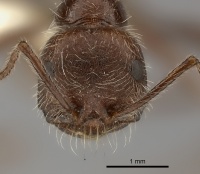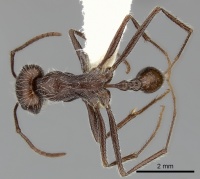Ocymyrmex flaviventris
| Ocymyrmex flaviventris | |
|---|---|

| |
| Scientific classification | |
| Kingdom: | Animalia |
| Phylum: | Arthropoda |
| Class: | Insecta |
| Order: | Hymenoptera |
| Family: | Formicidae |
| Subfamily: | Myrmicinae |
| Tribe: | Crematogastrini |
| Genus: | Ocymyrmex |
| Species: | O. flaviventris |
| Binomial name | |
| Ocymyrmex flaviventris Santschi, 1914 | |
Forder and Marsh (1989) observed from dissections that the ergatoid like queens of this species have larger, and many more, ovaries than workers.
Identification
A member of the hirsutus group. O. flaviventris is characterized by its light orange-yellow colour, keel-like process below the petiole peduncle, broad node, prominent metapleural glands and uneven cephalic sculpture. It is closest related to Ocymyrmex shushan and Ocymyrmex hirsutus, but in the former the promesonotum forms a conspicuous high dome and the latter lacks a keel-like subpeduncular process as well as having the cephalic sculpture transverse behind the level of the eyes. (Bolton 1981)
Keys including this Species
Distribution
Latitudinal Distribution Pattern
Latitudinal Range: -20.25° to -23.75°.
| North Temperate |
North Subtropical |
Tropical | South Subtropical |
South Temperate |
- Source: AntMaps
Distribution based on Regional Taxon Lists
Afrotropical Region: Botswana, Namibia, South Africa, United Republic of Tanzania.
Distribution based on AntMaps
Distribution based on AntWeb specimens
Check data from AntWeb
Countries Occupied
| Number of countries occupied by this species based on AntWiki Regional Taxon Lists. In general, fewer countries occupied indicates a narrower range, while more countries indicates a more widespread species. |

|
Estimated Abundance
| Relative abundance based on number of AntMaps records per species (this species within the purple bar). Fewer records (to the left) indicates a less abundant/encountered species while more records (to the right) indicates more abundant/encountered species. |

|
Biology
|
Castes
Nomenclature
The following information is derived from Barry Bolton's Online Catalogue of the Ants of the World.
- flaviventris. Ocymyrmex hirsutus var. flaviventris Santschi, 1914a: 431 (w.) TANZANIA. Bolton, 1981b: 261 (q.). Raised to species: Bolton, 1981b: 268. See also: Bolton & Marsh, 1989: 1295.
Unless otherwise noted the text for the remainder of this section is reported from the publication that includes the original description.
Description
Worker
Bolton (1981) - TL 7.1-7.4, HL 1.64-1.80, HW 1.54-1.70, CI 93-97, SL 1.44-1.58, SI 90-96, PW 0.98-1.04, AL 2.04-2.28 (17 measured).
Anterior clypeal margin with a narrow but deep semicircular impression medially, the impression flanked by a pair of teeth. Occipital corners broadly rounded, the margin medially with a small indentation. Eyes with maximum diameter 0.38, about 0.22 x HW. Promesonotum in profile evenly shallowly convex, the propodeal dorsum posteriorly rounding narrowly into the declivity which is almost vertical. Metapleural glands swollen and projecting strongly to the rear, in profile concealing all but the extreme tips of the meta pleural lobes ; the projection of the metapleural glands enhanced by the near-vertical propodeal declivity. Peduncle of petiole ventrally with an elongate keel-like process which is semitranslucent and unsculptured, evenly shallow convex throughout its length. Petiole node small in profile, evenly rounded. In dorsal view the petiole node broader than long, the maximum width of the node about equal to the distance from the spiracle to the apex of the collar where the petiole articulates with the postpetiole. Postpetiole in dorsal view slightly longer than broad. Base of first gastral tergite constricted and forming a neck. Dorsum of head longitudinally very densely finely rugulose, the rugulae close-packed and irregular, being narrowly wavy or even minutely vermiculate in places. Ground-sculpture a conspicuous granulation or punctulation. Rugulae between and on median strip just behind the frontal lobes more regular than elsewhere. Dorsal alitrunk transversely densely rugose, the sculpture longitudinal only between the mesothoracic spiracles and on the arched portion of the pronotum. Sides of alitrunk rugose everywhere. Petiole with a few transverse rugae beneath the node and on the dorsum of the peduncle. Elsewhere on the petiole sculpture is vestigial to absent. Post petiole unsculptured except for faint superficial patterning. All dorsal surfaces of head and alitrunk with numerous hairs of varying length. PropodeaJ dorsum with long hairs arising from a fairly dense mat of much shorter hairs. First gastral tergite with sparse scattered hairs which are much shorter than those on the alitrunk. Colour bright orange-yellow, the gaster lighter and more yellow than the head and alitrunk.
Type Material
Bolton (1981) - Holotype worker, South West Africa: Windhoek (Viehmeyer) (NM, Basle) [examined].
References
- Bolton, B. 1981. A revision of six minor genera of Myrmicinae (Hymenoptera: Formicidae) in the Ethiopian zoogeographical region. Bulletin of the British Museum (Natural History) Entomology. 43:245-307. (page 261, queen described; page 268, Raised to species)
- Bolton, B. and A. C. Marsh. 1989. The Afrotropical thermophilic ant genus Ocymyrmex (Hymenoptera: Formicidae). Journal of Natural History. 23:1267-1308.
- Forder, J. C. and A. C. Marsh. 1989. Social organization and reproduction in Ocymyrmex foreli (Formicidae: Myrmicinae). Insectes Sociaux. 36:106-115.
- Santschi, F. 1914a [1913]. Mélanges myrmecologiques. Ann. Soc. Entomol. Belg. 57: 429-437 (page 431, worker described)
References based on Global Ant Biodiversity Informatics
- Bolton B. 1981. A revision of six minor genera of Myrmicinae (Hymenoptera: Formicidae) in the Ethiopian zoogeographical region. Bulletin of the British Museum (Natural History). Entomology 43: 245-307.
- Bolton B., and A. C. Marsh. 1989. The Afrotropical thermophilic ant genus Ocymyrmex (Hymenoptera: Formicidae). Journal of Natural History 23: 1267-1308.
- IZIKO South Africa Museum Collection

